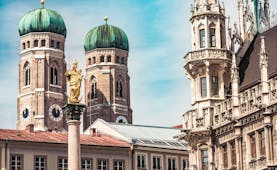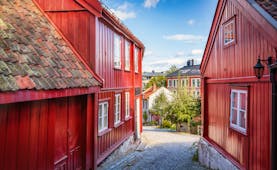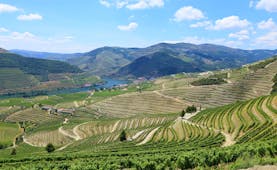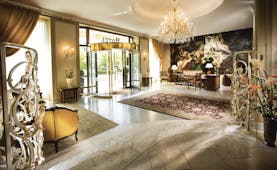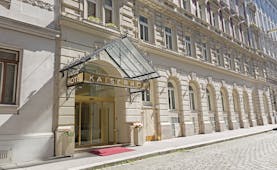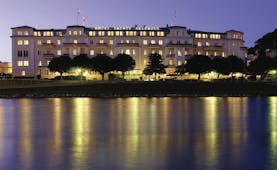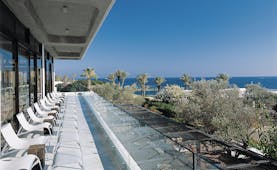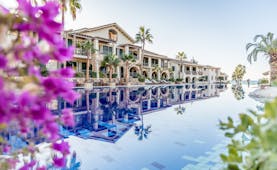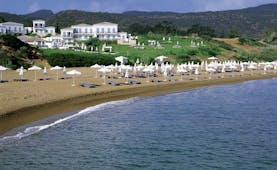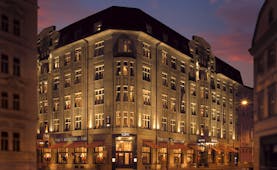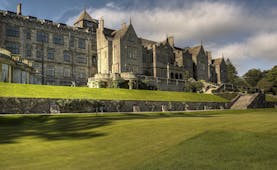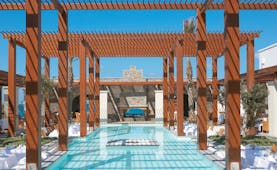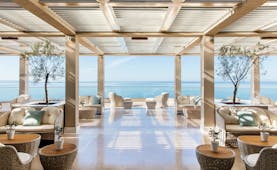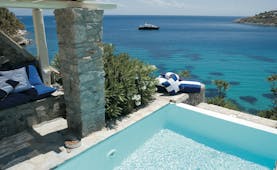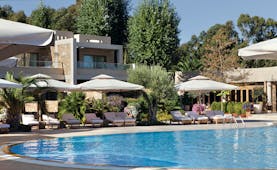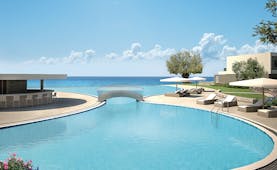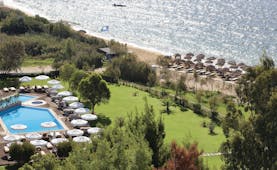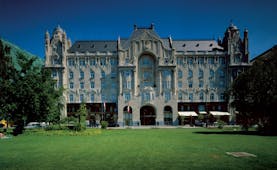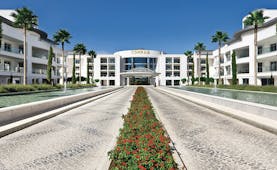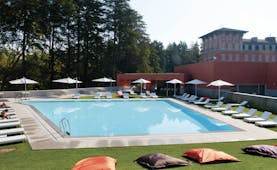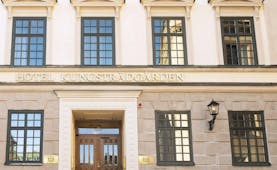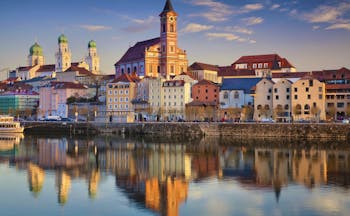Luxury rail tour visiting the cultural cities of the former GDR including Berlin, Dresden and Weimar
This 11-night luxury touring holiday by train begins with your arrival in Berlin by rail from London. You spend three nights in the German capital, which allows you plenty of time to discover the abundant museums, monuments, buildings and galleries that the city offers. The momentous events of recent history that Berlin has witnessed are ever-present, from the still obvious socialist architecture of Alexanderplatz, which was the hub of post-war East Berlin, the old crossing point of Checkpoint Charlie manned by the allied powers, the Holocaust Memorial located a stone’s throw from the iconic Brandenburg Gate, the Soviet War Memorial and Bebelplatz where books were burned in 1933. Berlin is a vast and imposing city. Travel around by underground (U-Bahn), S-Bahn (above ground local trains), trams and buses (including the famous Berlin double-decker buses) and bike. From Berlin travel to the fascinating, beautiful city of Dresden in two hours where you spend two nights. Dresden, the capital of the state of Saxony, is rich in history and easily explored on foot. Having recovered from wartime damage, Dresden is full of art and culture blending modern architecture with historical buildings. Highlights of your visit to Dresden should be the Zwinger Palace, inspired by Versailles, and housing Old Masters and a famous collection of Dresden porcelain. The Frauenkirche is a magnificent Baroque Protestant church, rebuilt after destruction int the Second World War. Your third destination is the city of Leipzig, known for its wide variety of cultural highlights mixed with evidence of its historical significance. The second largest city in the area of the former GDR, Leipzig has long been a major centre for music. Composer Bach lived and worked here and the Oper Leipzig is one of Germany’s most prominent opera houses. To get a feel of the city’s history you should visit Nikolaikirche, the site of demonstrations throughout the 1980s which played an instrumental part in the non-violent movement which eventually led to the fall of the Berlin Wall. Other historical highlights include the Monument to the Battle of the Nations, built in honour of the victory over Napoleon’s army in 1813, and the Museum in der “Runden Ecke”, which gives an in-depth look at what life was like under socialist control. You travel next to the beautiful Weimar, a cultural hub which has been home to multiple legendary personalities throughout history, including German writer Goethe, whose house is open to the public today to explore his precious collection of art and the National Museum on the upper floor. Another beautifully preserved monument to Weimar’s history is the Schloss and Park Belvedere. Now a museum containing 18th-century artwork and furniture, the palace sits in pretty gardens and still has historic carriages in the orangery. The Castle Museum and Bauhaus Museum will also give insights into the incredible art history of this small city. The final stop on your tour is Erfurt. Evidence of Erfurt’s 1,200-year long history can be seen clearly throughout the city, from the Kramerbrucke (Merchants’ Bridge), the longest medieval bridge in Europe to have inhabited houses, to Erfurt Cathedral, built mostly during the 14th and 15th centuries. You have one full day here to explore. Make sure to visit Zitadelle Petersburg, the largest and best-preserved Baroque city fortress in Central Europe. This was turned into a tourist attraction after Germany’s reunification and offers wonderful vistas of the city.
Highlights
Berlin • Dresden • Leipzig • Weimar • Erfurt
Day by day
Begin your Former cities of the GDR rail touring holiday by travelling from London to Brussels by Eurostar on an early morning departure. With a change of trains in Brussels, continue to Berlin, changing once more in Cologne. You arrive in Berlin just after 7pm and check-in to your hotel for three nights.
You have two days to explore Berlin at your leisure. Berlin has a fascinating history stretching back hundreds of years although it is really for its more recent history that it is best known. Berlin has been at the epicentre of two world wars and the Cold War in the course of the 20th century and is now the capital of a re-united Germany. Its rich history means that there is a vast amount to discover. Major attractions include The Reichstag, German Parliament, which was built in the 19th century and destroyed in 1933 and Brandenburg Gate, which was inspired by the Acropolis in Athens, and at the head of the long boulevard, Unter den Linden (named after the rows of linden trees planted almost 400 years ago). Your second day in Berlin gives you ample time to explore another important cultural place of interest such as Museum Island where 5 museums are located. These include the Pergamon Museum which houses 3 separate collections; the Museum of Antiquities (from Greece and Rome), the Museum of Near Eastern Antiquities and the Museum of Islamic Art as well as Neues Museum which hosts Egyptian and prehistoric items. Apart from all the museums that the city has to offer, Berlin is also home to one of the oldest zoos in Germany situated in Tiergarten Park. Take a stroll by the Landwehr Canal which is seven miles in length which will take you through some of the city’s sights including Kreuzberg’s café-lined embankments and part of Tiergarten park. Berlin is a very large city and covers an area of just under 900 sq. kms.
After three nights in Berlin, you take a direct train to Dresden where you arrive in under 2 hours. You stay in Dresden for two nights.
Spend your time in Dresden exploring the palaces and historical buildings that the city has to offer. Dresden has a prominent creative scene and is often hailed as the most attractive city in Germany. For history enthusiasts, a visit to Frauenkirche and Neumarkt Square is a must. The Frauenkirche was rebuilt after World War Two and has become a symbol of reconciliation. A fine example of well-preserved Renaissance architecture is the Residenzschloss (Royal Palace) situated in the historic town centre. Semper Opera House is visually stunning and is the main venue for Dresden’s Saxon State Orchestra. Another architectural gem to visit is the Zwinger Palace. This palace is built in baroque style after the Palace of Versailles and combines architecture, sculpture and painting. Dresden is known for its porcelain and a national collection can be found in the Zwinger.
Today you travel from Dresden to Leipzig. This journey takes just over an hour and trains run regularly, so you can choose to either spend the morning in Dresden or take an earlier train and have more time in Leipzig. Check in to your hotel in Leipzig where you will spend the next two nights.
You have one full day to take in the sights in Leipzig. For those interested in history, the two churches should be your first port of call. St Nicholas Church (Nikolaikirche) was built in the 12th century and is perhaps best-known for being the site of the peaceful demonstrations which helped to bring about the fall of the Berlin Wall. St Thomas Church was built a century earlier and has a significant history; composer Bach was the church’s choirmaster for almost thirty years and Martin Luther preached here 1539. Northeast of St Thomas Church is the Markt, dominated by the Old City Hall (Rathaus), widely considered one of the most beautiful Renaissance buildings in the country. Today the Rathaus is home to a museum filled with artefacts and pictures from Leipzig’s history. Slightly further out of the centre is the Battle of the Nations Monument, completed in 1913 to commemorate the 100th Anniversary of Napoleon’s defeat at the Battle of the Nations. The viewing platform offers incredible views, but there is no elevator so this may be more difficult for those with mobility difficulties. Spend the rest of your day wandering the old shopping arcades of Mädlerpassage and Naschmarkt with their coveted courtyards, or perhaps visit one of Leipzig’s fascinating museums, including the Mendelssohn House, the Coffe Baum Coffee Museum and the Museum of Fine Arts.
Take a direct train from Leipzig to Weimar, departing around quarter past 10 and arriving just before midday. You spend two nights in your luxury hotel in Weimar.
The historic town of Weimar has played host to numerous legendary personalities, now immortalised in the many monuments and museums throughout the centre. For lovers of literature, the Goethe House and National Museum will be one of the most interesting attractions. Goethe lived here from 1782 until his death in 1832, and the house today is filled with his precious collection of art and his well-stocked library, as well as the National Museum on the upper floor. The Duchess Anna Amalia Library and Schiller’s Home also give an insight into the history of this literary hub; the Library contains an unrivalled collection of classic literature whilst Schiller’s Home contains a museum displaying a collection of materials pertaining to the life and works of Schiller. It is recommended to book tickets in advance for the Duchess Anna Amalia Library as this is a very popular attraction. The Castle Museum with its collection of art from the Middle Ages and Renaissance Period is a must-see for art lovers – the stunning interiors themselves are well worth a visit. On the edge of Weimar is the 18th century Schloss Belvedere. This museum was originally a summer pleasure palace and today contains an impressive collection of 18th-century porcelain, furniture and artwork. The English-styled garden in which it is located make for a pleasant stroll when the weather is good.
The journey from Weimar to Erfurt takes only 20 minutes, so can be done at a time of your choosing. Upon arrival in Erfurt, check in to your hotel for the last two nights of your rail holiday to the cities of the former GDR.
Erfurt is filled with beautiful buildings which play testament to its fascinating history. Perhaps start your day by visiting the food market which takes place in the morning from Monday to Saturday in Domplatz, the largest square in the city. Here you can buy traditional German food such as sausages, cheese and honey, as well as some exotic delicacies. Overlooking this square is the Gothic Erfurt Cathedral. The Cathedral itself was built mostly in the 14th and 15th centuries, but there has been a religious building here since St Boniface founded a church in 742. The Medieval art inside the cathedral is almost all original, from its tracery windows to the Wolfram candelabra dating from around the 12th century. Right in the centre of the city is the Zitadelle Petersburg, the best-preserved Baroque city fortress in Central Europe. Founded in 1665, this site was turned into a tourist attraction after Germany’s reunification and now offers amazing views of the city from its parapet wall. Other historical buildings of interest include the Augustinerkloster, where Martin Luther became a monk and stayed between 1505 and 1511, and the Old Synagogue, which may be the best-preserved Medieval synagogue in Europe. The Angersmuseum, housed in a beautiful Baroque building, features an extensive range of art from the Middle Ages to the present day.
Depart Erfurt at about quarter past 8 in the morning for Brussels, changing trains in Frankfurt. Check in for your Eurostar in Brussels which will take you back to London. You arrive into St Pancras in the evening.
Always happy with travel arrangements and hotel suggestions made and the options put forward by Expressions. Always very responsive and reassuring.Ms M, June 2025
Holiday price guide From £2,790 per person based on two people sharing a double or twin room and including second class rail travel. First class and standard premier on Eurostar supplement of £640 per person.
Holiday Code EEBR11
Call us on 01392 441245
Luxury rail tour visiting the cultural cities of the former GDR including Berlin, Dresden and Weimar
Begin your Former cities of the GDR rail touring holiday by travelling from London to Brussels by Eurostar on an early morning departure. With a change of trains in Brussels, continue to Berlin, changing once more in Cologne. You arrive in Berlin just after 7pm and check-in to your hotel for three nights.
You have two days to explore Berlin at your leisure. Berlin has a fascinating history stretching back hundreds of years although it is really for its more recent history that it is best known. Berlin has been at the epicentre of two world wars and the Cold War in the course of the 20th century and is now the capital of a re-united Germany. Its rich history means that there is a vast amount to discover. Major attractions include The Reichstag, German Parliament, which was built in the 19th century and destroyed in 1933 and Brandenburg Gate, which was inspired by the Acropolis in Athens, and at the head of the long boulevard, Unter den Linden (named after the rows of linden trees planted almost 400 years ago). Your second day in Berlin gives you ample time to explore another important cultural place of interest such as Museum Island where 5 museums are located. These include the Pergamon Museum which houses 3 separate collections; the Museum of Antiquities (from Greece and Rome), the Museum of Near Eastern Antiquities and the Museum of Islamic Art as well as Neues Museum which hosts Egyptian and prehistoric items. Apart from all the museums that the city has to offer, Berlin is also home to one of the oldest zoos in Germany situated in Tiergarten Park. Take a stroll by the Landwehr Canal which is seven miles in length which will take you through some of the city’s sights including Kreuzberg’s café-lined embankments and part of Tiergarten park. Berlin is a very large city and covers an area of just under 900 sq. kms.
After three nights in Berlin, you take a direct train to Dresden where you arrive in under 2 hours. You stay in Dresden for two nights.
Spend your time in Dresden exploring the palaces and historical buildings that the city has to offer. Dresden has a prominent creative scene and is often hailed as the most attractive city in Germany. For history enthusiasts, a visit to Frauenkirche and Neumarkt Square is a must. The Frauenkirche was rebuilt after World War Two and has become a symbol of reconciliation. A fine example of well-preserved Renaissance architecture is the Residenzschloss (Royal Palace) situated in the historic town centre. Semper Opera House is visually stunning and is the main venue for Dresden’s Saxon State Orchestra. Another architectural gem to visit is the Zwinger Palace. This palace is built in baroque style after the Palace of Versailles and combines architecture, sculpture and painting. Dresden is known for its porcelain and a national collection can be found in the Zwinger.
Today you travel from Dresden to Leipzig. This journey takes just over an hour and trains run regularly, so you can choose to either spend the morning in Dresden or take an earlier train and have more time in Leipzig. Check in to your hotel in Leipzig where you will spend the next two nights.
You have one full day to take in the sights in Leipzig. For those interested in history, the two churches should be your first port of call. St Nicholas Church (Nikolaikirche) was built in the 12th century and is perhaps best-known for being the site of the peaceful demonstrations which helped to bring about the fall of the Berlin Wall. St Thomas Church was built a century earlier and has a significant history; composer Bach was the church’s choirmaster for almost thirty years and Martin Luther preached here 1539. Northeast of St Thomas Church is the Markt, dominated by the Old City Hall (Rathaus), widely considered one of the most beautiful Renaissance buildings in the country. Today the Rathaus is home to a museum filled with artefacts and pictures from Leipzig’s history. Slightly further out of the centre is the Battle of the Nations Monument, completed in 1913 to commemorate the 100th Anniversary of Napoleon’s defeat at the Battle of the Nations. The viewing platform offers incredible views, but there is no elevator so this may be more difficult for those with mobility difficulties. Spend the rest of your day wandering the old shopping arcades of Mädlerpassage and Naschmarkt with their coveted courtyards, or perhaps visit one of Leipzig’s fascinating museums, including the Mendelssohn House, the Coffe Baum Coffee Museum and the Museum of Fine Arts.
Take a direct train from Leipzig to Weimar, departing around quarter past 10 and arriving just before midday. You spend two nights in your luxury hotel in Weimar.
The historic town of Weimar has played host to numerous legendary personalities, now immortalised in the many monuments and museums throughout the centre. For lovers of literature, the Goethe House and National Museum will be one of the most interesting attractions. Goethe lived here from 1782 until his death in 1832, and the house today is filled with his precious collection of art and his well-stocked library, as well as the National Museum on the upper floor. The Duchess Anna Amalia Library and Schiller’s Home also give an insight into the history of this literary hub; the Library contains an unrivalled collection of classic literature whilst Schiller’s Home contains a museum displaying a collection of materials pertaining to the life and works of Schiller. It is recommended to book tickets in advance for the Duchess Anna Amalia Library as this is a very popular attraction. The Castle Museum with its collection of art from the Middle Ages and Renaissance Period is a must-see for art lovers – the stunning interiors themselves are well worth a visit. On the edge of Weimar is the 18th century Schloss Belvedere. This museum was originally a summer pleasure palace and today contains an impressive collection of 18th-century porcelain, furniture and artwork. The English-styled garden in which it is located make for a pleasant stroll when the weather is good.
The journey from Weimar to Erfurt takes only 20 minutes, so can be done at a time of your choosing. Upon arrival in Erfurt, check in to your hotel for the last two nights of your rail holiday to the cities of the former GDR.
Erfurt is filled with beautiful buildings which play testament to its fascinating history. Perhaps start your day by visiting the food market which takes place in the morning from Monday to Saturday in Domplatz, the largest square in the city. Here you can buy traditional German food such as sausages, cheese and honey, as well as some exotic delicacies. Overlooking this square is the Gothic Erfurt Cathedral. The Cathedral itself was built mostly in the 14th and 15th centuries, but there has been a religious building here since St Boniface founded a church in 742. The Medieval art inside the cathedral is almost all original, from its tracery windows to the Wolfram candelabra dating from around the 12th century. Right in the centre of the city is the Zitadelle Petersburg, the best-preserved Baroque city fortress in Central Europe. Founded in 1665, this site was turned into a tourist attraction after Germany’s reunification and now offers amazing views of the city from its parapet wall. Other historical buildings of interest include the Augustinerkloster, where Martin Luther became a monk and stayed between 1505 and 1511, and the Old Synagogue, which may be the best-preserved Medieval synagogue in Europe. The Angersmuseum, housed in a beautiful Baroque building, features an extensive range of art from the Middle Ages to the present day.
Depart Erfurt at about quarter past 8 in the morning for Brussels, changing trains in Frankfurt. Check in for your Eurostar in Brussels which will take you back to London. You arrive into St Pancras in the evening.
Always happy with travel arrangements and hotel suggestions made and the options put forward by Expressions. Always very responsive and reassuring.Ms M, June 2025
Holiday price guide From £2,790 per person based on two people sharing a double or twin room and including second class rail travel. First class and standard premier on Eurostar supplement of £640 per person.
Holiday Code EEBR11
Our prices include
● Rail travel from London throughout, back to London
● Second-class travel on all trains (first class and standard premier on Eurostar can be booked at a supplement)
● 3 nights’ bed and breakfast in a Classic double room at Hotel de Rome, Berlin
● 2 nights’ bed and breakfast in a Comfort double room at Hotel Bülow Palais, Dresden
● 2 nights’ bed and breakfast in a Standard double room at Victor’s Residenz-Hotel, Leipzig
● 2 nights’ bed and breakfast in a Classic double room at Hotel Elephant, Weimar
● 2 nights’ bed and breakfast in a Premium double room at Hotel Domizil, Erfurt
● Concierge service and Expressions Holidays regional helpful hints
Our prices do not include
● Early check-in or late check-out at any hotels (although we can arrange this on request at additional cost)
● Any other services not mentioned above, such as transfers and meals except breakfast at hotels
● Personal holiday insurance. This is essential and cover should be in place from when you book the holiday.
● Local tourist tax, usually between Euros 1 and 3 per person per night, and payable locally to the hotel
● Transfers in any cities
Additional information This holiday can be arranged throughout the year. Timings can vary depending on the month and day of the week.
Call us on 01392 441245
Luxury rail tour visiting the cultural cities of the former GDR including Berlin, Dresden and Weimar

The Hotel de Rome Berlin is a prestigious 5-star hotel in an excellent central location. Delicious Italian cuisine, luxury spa facilities and beautiful rooftop terrace make it an ideal spot to recuperate after enjoying the delights of Berlin.
Classic double room

Hotel Bülow Palais is a super five-star Relais & Chateaux hotel that offers a unique style with excellent dining and spa facilities. Located in the centre of Dresden, this hotel is a luxurious retreat after exploring the city.
Comfort double room
Always happy with travel arrangements and hotel suggestions made and the options put forward by Expressions. Always very responsive and reassuring.Ms M, June 2025
Holiday price guide From £2,790 per person based on two people sharing a double or twin room and including second class rail travel. First class and standard premier on Eurostar supplement of £640 per person.
Holiday Code EEBR11
Call us on 01392 441245
Luxury rail tour visiting the cultural cities of the former GDR including Berlin, Dresden and Weimar
About Germany
An Expressions tailor-made holiday to Germany enables travellers to experience a fascinating and richly varied country. Germany is replete with regional quirks and personalities - a strong feature of German life and a hangover from the days, not too long ago, when the country was once a patchwork of independent states. Today, to travel from the ancient ports of the north, across the open fields of the German plain, and down through the Ruhr and onto the forests, mountains and cosmopolitan cities of Germany’s Bavarian south, you’ll experience an intriguing variety as great – and appealing – as you’d find anywhere else in Europe. Several of Germany’s cities have the air of national capitals. Cologne, though enmeshed in one of Europe’s most intensively industrialised regions, is rich in monuments. Bavaria’s capital, Munich, is another star attraction, with great museums and galleries. Berlin, the nucleus of the turmoil of reunification, is now one of the most sophisticated, artistic and exciting cities on the planet, while Nuremberg is thrillingly ancient, with the most charming of winter markets in the 11th century square, and summer festivals when the cobbled streets come alive with street artists and musicians. Scattered between these city big-hitters, quieter, utterly charming cities and large towns abound, with medieval old towns straight out of fairy-tale picture books. Heidelberg, the oldest university town in Germany, is an absolute gem, nestling between wooded hills on the banks of the Neckar river, a setting that has seduced visitors ever since the days of the Grand Tour. But from Trier to Bamberg, Marburg to Meissen, Regensburg to Rothenburg, enchanting old towns abound. Beyond Germany’s beautiful cities and towns, the Bavarian Alps, right on Munich’s doorstep, are a spectacular playground for hikers and bikers, horse-riders and skiers. The Rhine and Mosel are both littered with castles and vineyards, offering an enchanting backdrop for the cruise boats that drift serenely along their waters. And stretching more than 100 miles north to south, and 45 miles from east to west, the Black Forest is awash with pretty spa towns and exquisite health resorts, crisscrossed with walking trails. The Black Forest also boasts some of the most spectacular rail journals on the planet. A beautiful, intriguing country vastly at odds with its stiff stereotype, Germany is a wonderful holiday destination for active outdoorsy types and city-breakers alike.
Highlights of Germany
Berlin’s world-class museums, bustling bars, galleries and monuments; Rugen Island, with its rugged chalk cliffs, windswept beaches, Romantic-era spa architecture and tree-lined country roads; Dresden, with its baroque beauty on the banks of the majestic Elbe; Cologne’s magnificent cathedral; the UNESCO World Heritage city of Bamberg; the sandy dunes of Sylt, a North Sea island with fabulous beaches and surf; the beer halls of Munich, ideally in September during the Oktoberfest; Lubeck, a Hanseatic gem; Muritz National Park, where you can go paddling and camping in a paradise teeming with birds; Bremen, a metropolis in miniature, with lovely red-brick and Art Nouveau architecture; the Alpine resorts of Bavaria, including Berchtesgaden, with dramatic peaks, dreamy lakes and superb walking trails; drive or cruise along the Rhine or Mosel, visiting castles, medieval villages and superb vineyards along the way; the walled medieval towns of Rothenburg and Trier, both with wonderful Christmas markets; the Christmas market at Nuremberg, oldest – and still most picturesque – in the world.
Facts in brief
Capital BerlinAirport Several airports are served from the UK, including Berlin, Bremen, Cologne-Bonn, Dortmund, Dresden, Dusseldorf, Frankfurt, Hamburg, Hannover, Stuttgart and Munich.
Size 137,000 sq. miles
Population 82 million
















